The iPhone 5 Review
by Anand Lal Shimpi, Brian Klug & Vivek Gowri on October 16, 2012 11:33 AM EST- Posted in
- Smartphones
- Apple
- Mobile
- iPhone 5
GPU Analysis/Performance
Section by Anand Shimpi
Understanding the A6's GPU architecture is a walk in the park compared to what we had to do to get a high level understanding of Swift. The die photos give us a clear indication of the number of GPU cores and the width of the memory interface, while the performance and timing of release fill in the rest of the blanks. Apple has not abandoned driving GPU performance on its smartphones and increased the GPU compute horsepower by 2x. Rather than double up GPU core count, Apple adds a third PowerVR SGX 543 core and runs the three at a higher frequency than in the A5. The result is roughly the same graphics horsepower as the four-core PowerVR SGX 543MP4 in Apple's A5X, but with a smaller die footprint.
As a recap, Imagination Technologies' PowerVR SGX543 GPU core features four USSE2 pipes. Each pipe has a 4-way vector ALU that can crank out 4 multiply-adds per clock, which works out to be 16 MADs per clock or 32 FLOPS. Imagination lets the customer stick multiple 543 cores together, which scales compute performance linearly.
SoC die size however dictates memory interface width, and it's clear that the A6 is significantly smaller in that department than the A5X, which is where we see the only tradeoff in GPU performance: the A6 maintains a 64-bit LPDDR2 interface compared to the 128-bit LPDDR2 interface in the A5X. The tradeoff makes sense given that the A5X has to drive 4.3x the number of pixels that the A6 has to drive in the iPhone 5. At high resolutions, GPU performance quickly becomes memory bandwidth bound. Fortunately for iPhone 5 users, the A6's 64-bit LPDDR2 interface is a good match for the comparatively low 1136 x 640 display resolution. The end result is 3D performance that looks a lot like the new iPad, but in a phone:
| Mobile SoC GPU Comparison | |||||||||||
| Adreno 225 | PowerVR SGX 540 | PowerVR SGX 543MP2 | PowerVR SGX 543MP3 | PowerVR SGX 543MP4 | Mali-400 MP4 | Tegra 3 | |||||
| SIMD Name | - | USSE | USSE2 | USSE2 | USSE2 | Core | Core | ||||
| # of SIMDs | 8 | 4 | 8 | 12 | 16 | 4 + 1 | 12 | ||||
| MADs per SIMD | 4 | 2 | 4 | 4 | 4 | 4 / 2 | 1 | ||||
| Total MADs | 32 | 8 | 32 | 48 | 64 | 18 | 12 | ||||
| GFLOPS @ 200MHz | 12.8 GFLOPS | 3.2 GFLOPS | 12.8 GFLOPS | 19.2 GFLOPS | 25.6 GFLOPS | 7.2 GFLOPS | 4.8 GFLOPS | ||||
We ran through the full GLBenchmark 2.5 suite to get a good idea of GPU performance. The results below are largely unchanged from our iPhone 5 Performance Preview, with the addition of the Motorola RAZR i and RAZR M. I also re-ran the iPad results on iOS 6, although I didn't see major changes there.
We'll start out with the raw theoretical numbers beginning with fill rate:
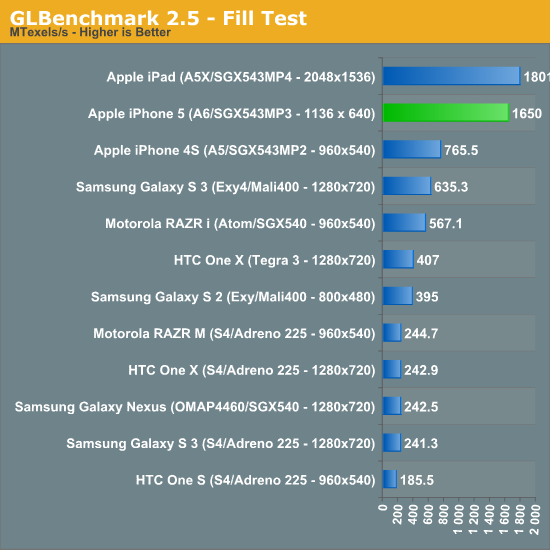
The iPhone 5 nips at the heels of the 3rd generation iPad here, at 1.65GTexels/s. The performance advantage over the iPhone 4S is more than double, and even the Galaxy S 3 can't come close.
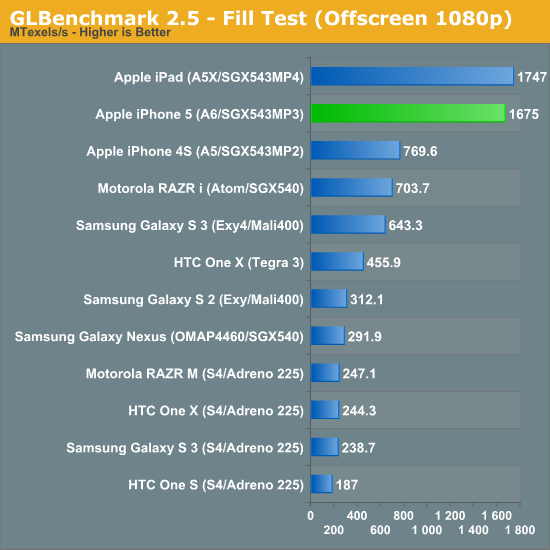
Triangle throughput is similarly strong:

Take resolution into account and the iPhone 5 is actually faster than the new iPad, but normalize for resolution using GLBenchmark's offscreen mode and the A5X and A6 look identical:
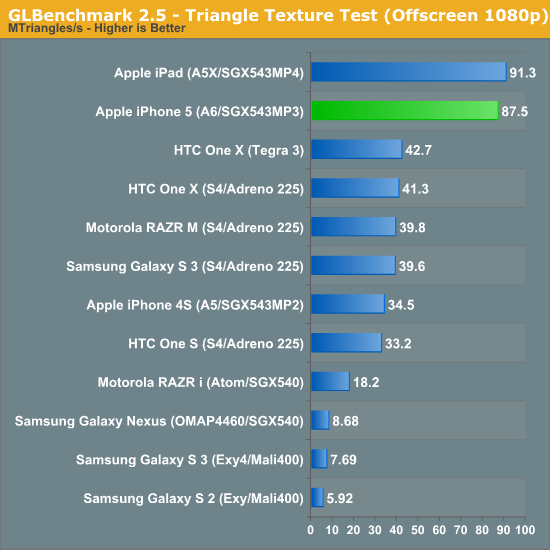
The fragment lit texture test does very well on the iPhone 5, once again when you take into account the much lower resolution of the 5's display performance is significantly better than on the iPad:
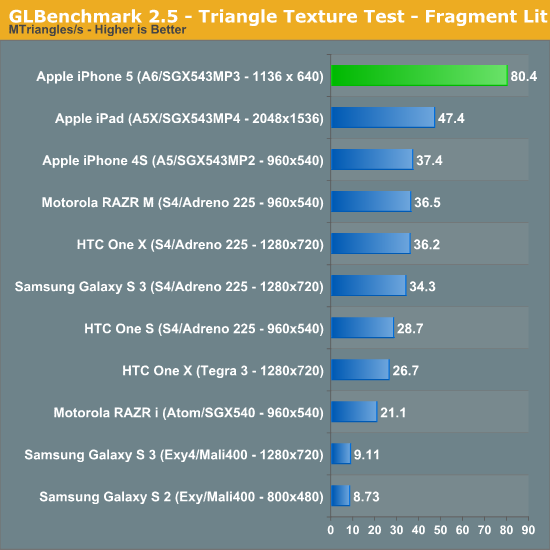
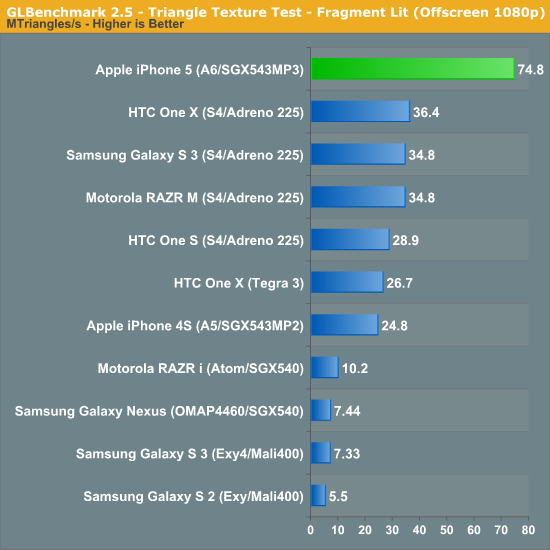

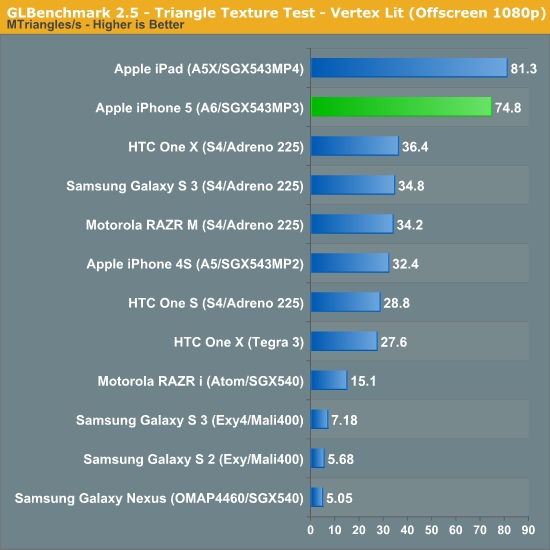
The next set of results are the gameplay simulation tests, which attempt to give you an idea of what game performance based on Kishonti's engine would look like. These tests tend to be compute monsters, so they'll make a great stress test for the iPhone 5's new GPU:
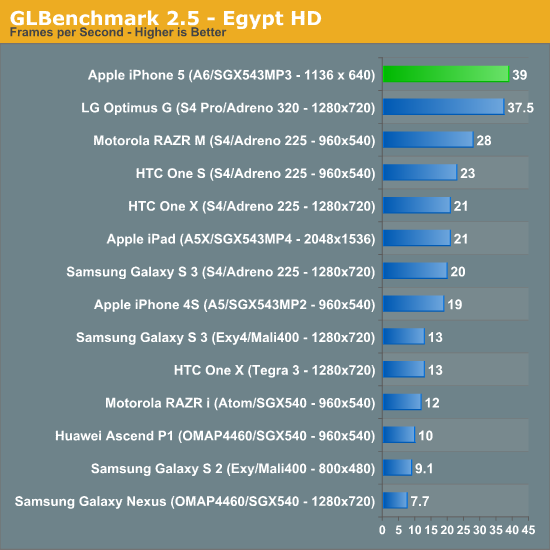
Egypt HD was the great equalizer when we first met it, but the iPhone 5 does very well here. The biggest surprise however is just how well the Qualcomm Snapdragon S4 Pro with Adreno 320 GPU does by comparison. LG's Optimus G, a device Brian flew to Seoul, South Korea to benchmark, is hot on the heels of the new iPhone.
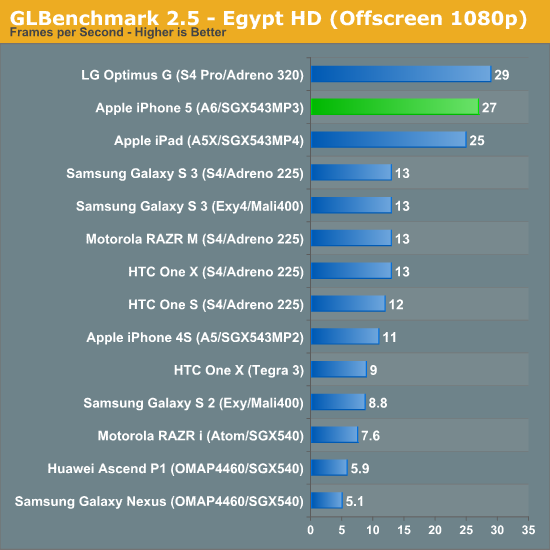
When we run everything at 1080p the iPhone 5 looks a lot like the new iPad, and is about 2x the performance of the Galaxy S 3. Here, LG's Optimus G actually outperforms the iPhone 5! It looks like Qualcomm's Adreno 320 is quite competent in a phone. Note just how bad Intel's Atom Z2460 is, the PowerVR SGX 540 is simply unacceptable for a modern high-end SoC. I hope Intel's slow warming up to integrating fast GPUs on die doesn't plague its mobile SoC lineup for much longer.
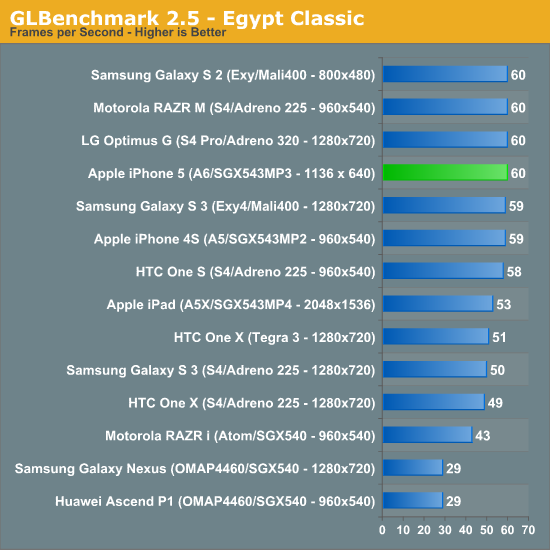
The Egypt classic tests are much lighter workloads and are likely a good indication of the type of performance you can expect from many games today available on the app store. At its native resolution, the iPhone 5 has no problems hitting the 60 fps vsync limit.
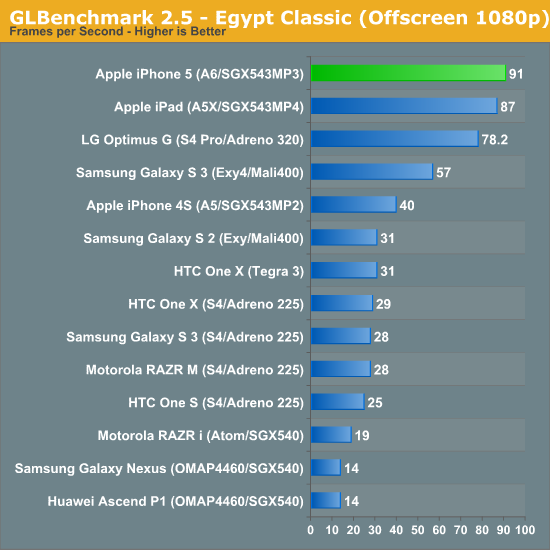
Remove vsync, render at 1080p and you see what the GPUs can really do. Here the iPhone 5 pulls ahead of the Adreno 320 based LG Optimus G and even slightly ahead of the new iPad.
Once again, looking at GLBenchmark's on-screen and offscreen Egypt tests we can get a good idea of how the iPhone 5 measures up to Apple's claims of 2x the GPU performance of the iPhone 4S:
Removing the clearly vsync limited result from the on-screen Egypt Classic test, the iPhone 5 performs about 2.26x the speed of the 4S. If we include that result in the average you're still looking at a 1.95x average. As we've seen in the past, these gains don't typically translate into dramatically higher frame rates in games, but games with better visual quality instead.











276 Comments
View All Comments
mykebrian - Thursday, October 18, 2012 - link
is motorola razr i same price with iphone 5?Death666Angel - Thursday, October 18, 2012 - link
"By controlling its own SoC destiny it could achieve a level of vertical integration that no OEM has enjoyed in recent history."I would argue that Samsung enjoys a similar level of vertical integration. They trade the OS-stuff for some fabs. Not sure which can be more profitable. But other than that, they are very much like Apple in terms of vertical smartphone integration I think. :)
iwod - Thursday, October 18, 2012 - link
Any Reason Why Front Camera not using High Profile When Recording Video? It could have saved yet another bit of space with MUCH better quality then baseline.And do Apple offically support play back of H.264 High Profile Video Clip yet?
Spunjji - Friday, October 19, 2012 - link
I very much appreciated the details on the SoC design. Your attempts to refine your battery life analysis were also appreciated, as these do seem to better reflect real-world usage. In general this article was well-researched, well-written and very informative.Unfortunately, the section on the anodization process does end up reading like one big apology. The matter is explained in detail but it's done with an air of resignation, as if this were the only option available to Apple. The fact is that they could have retained some additional girth (whilst still losing some) and had a device with good handling, good aesthetics and superior durability. No comparison to competing devices is made whatsoever, so we have no idea based on your article alone if this really is unavoidable or just poor choice of materials.
The same goes for the part about the camera flare. Is a short comparison with a few relevant models too much to ask? The problem is that (like the previous criticism) I already know how this comes out and it doesn't look very good for Apple.
So there are hundreds of hours spent testing comparative performance and battery life where Apple win, yet no time at all dedicated to comparative analysis where they do not look so good. That starts to look upsettingly like bias. I hope that isn't the case but based on other areas (notebook reviews in particular) it starts to feel like a theme.
Anandtech, as a site I love your tech journalism, but the personal preferences of the writers need to stay at home (or firmly in editorials).
Slaanesh - Friday, October 19, 2012 - link
Couldn't agree more.Krysto - Friday, October 19, 2012 - link
I have to agree. Through out the article, you almost got the impression of worship from the writers, and they've only focused on what Apple did right and how much better that was than their competitors.And what's with all the going back to history of Apple's devices? Was that really necessary for a phone review? Should we expect this for all new iPhones...or for all new Galaxy S devices? I think that part alone shows bias.
And was 50 page review (or whatever it is) really necessary and to wait a month and a half after the product launch? The reason I'm asking is because I know they will never repeat this for any other non-Apple product. But I also think it's kind of pointless, and reviews need to appear max 1 week after the product launches. Maybe two. More than that is really pointless, and it's already obvious in the review that half of it is about how awesome Apple were in the past and still are, and only the other half goes down to the analysis.
dyc4ha - Saturday, October 20, 2012 - link
+1Klugfan - Friday, October 19, 2012 - link
Does everyone remember Edward Tufte's complaints about the iPhone 4 design?If I wasn't concerned about impact on the antenna performance, I'd be tempted to take some fine grit sandpaper to my black iPhone 5, and round off the edges a little. Believe it.
If your biggest concern about phones _really_ is resale value, well the iPhone 5 will do fine, with or without scuffs. If your biggest concern about brain phones is what they look like to other people who see you using them, well, first you're an idiot, and second the iPhone 5 really will do fine there, with or without scuffs.
Does my phone make me look smug? Whatever shall I do.
Hxx - Friday, October 19, 2012 - link
got this phone close to release day and I'm throughly impressed with it. Coming from a droid incredible 2 who crapped out on me 10 months after purchase (the memory slot broke and lost all my pics, videos etc - not fun) I gotta say this is my first interaction with an iOS powered device and so far i love it. I think most Apple products are overpriced (hence the reason why i never got one) but this phone is a beauty for $199 given that i paid almost just as much 1 year ago for my droid phone. A huge thank you to Anandtech for providing such detailed review. Although i may never need as much detail about a phone :-), its nice to know i can always rely on you guys if I ever have any technical questions.Good job Guys!
ol1bit - Friday, October 19, 2012 - link
As always, Anandtech gets into the details I didn't even know I wanted to read about!I'm not an apple product owner, and never plan to be, but it really appears to be a great phone.
Keep up the good work!